A few weeks before our wedding Brandon and I were out running errands when we saw this sign outside a vacated shop:
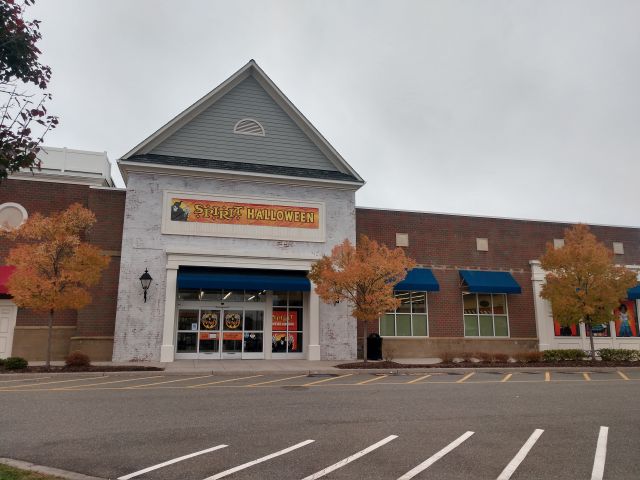
It wasn’t the first time either of us had seen such a banner. On the contrary, we’d been expecting one to pop up somewhere in town. Like the turning of the foliage itself, the rampant proliferation of anything related to pumpkin spice, or the propagation of seasonal candy in grocery stores, the annual appearance of the Spirit Halloween stores signifies the arrival of autumn and the holiday festivities that go with it. We’d seen one last year, and we’ll undoubtedly see one next October, in a different location perhaps, but there nonetheless.
It did get me thinking about holiday stores though, and particularly the differences between Christmas shops and Halloween shops. To be clear, I’m not talking about outdoor Christmas markets or other temporary events: I mean year-round shops dedicated exclusively to Christmas (and occasionally with a dash of Halloween thrown in to appease customers who prefer spookiness to coziness). Williamsburg has at least three of them if you count the two branches of the Christmas Mouse and the Christmas Shop on Merchants Square, and it wouldn’t surprise me if there were others I don’t know about. I’ve long had a casual interest in Christmas shops as a phenomenon but seeing the Spirit Halloween sign got me thinking about the differences between holiday stores.
And what interests me about these stores, you ask? I’m compelled by their different business models, and how one emphasizes permanence while the other relies on transience (also, here are a couple of interesting articles from Business Insider that discuss the popularity of Spirit Halloween in the wake of meme culture and the so-called Retail Apocalypse).
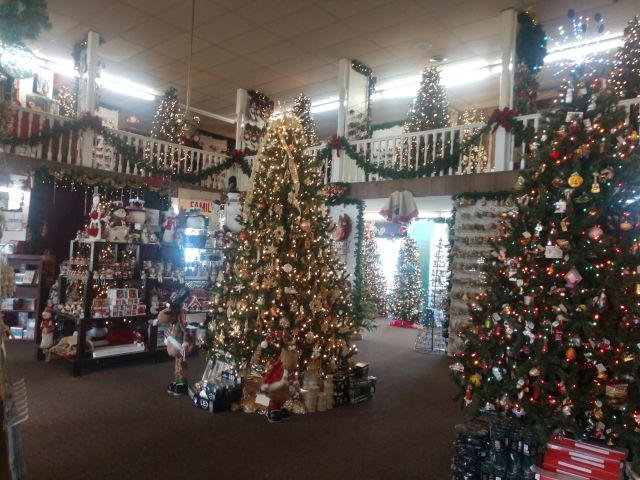

Let me be frank: as a concept, I tend to like Christmas shops better in theory than in practice. I do have fond memories of visiting a store called the Christmas Dove as a kid, a place that’s been open for nearly 50 years and has over thirty rooms in its complex. But I think those memories stem as much from being with family as it does from the store itself. Looking back, it isn’t so much the shop that stands out in my recollections, but being on Christmas break and having fun with my family as we looked at the different wares on display.
I’ve visited other Christmas shops since then, but I tend to find them overwhelming and, dare I say, a bit tacky. I think part of it stems from the variety of products on display. In order to attract as many customers as possible, Christmas shops appeal to a variety of tastes. As such, you’re seeing decorations to suit everyone’s preferences, which means a lot of it simply won’t appeal to you. A decoration that appears charming or cute to one person might be ugly or crass to another, and so on. There’s also something about seeing so many different kinds of decorations in multiple that really emphasizes the commercial side of the holiday. The uniqueness of your experiences really gets put in perspective when you see five hundred copies of the same nutcracker waiting to be purchased. A Christmas Carol might have emphasized the importance of keeping the holiday in your heart year-round, but I doubt Dickens had the ample merchandise of the Christmas store in mind when he wrote that.

There’s also an immersive quality to Christmas stores that I find fascinating and unnerving at the same time. Many of these stores play Christmas music on loop or have the scents of peppermint, cinnamon, and other fragrances associated with the holiday wafting through the air. Other stores will have entire diorama-type displays set up in them. I remember going to one Christmas store in Vermont that had an entire recreation of a quaint New England village on Christmas Eve, complete with faux carolers. Going into one of these shops is like walking into a Hallmark Christmas movie, where everything is quaint, cozy, and, depending on how you feel about such movies, heartwarming or maudlin. Their immersion in the holiday and its environment (or rather, a specific version of that environment, because most of us do not live in merry old New England) is not unlike the experience you might get at amusement parks like Disney. No matter what time of year, if you need a Christmas fix, you can go into one of these stores. Some people like that, apparently enough to keep these places open. For me personally, walking into a full-on Christmas environment in April or August is disorienting, but then again, it doesn’t take much to overwhelm me.
That sense of permanence, the idea that these places exist all year solely for the point of commemorating Christmas, is one of the reasons why I find the model that Spirit Halloween uses so interesting. Halloween is as popular, arguably more popular, as Christmas in the United States, but you rarely see permanent brick-and-mortar stores dedicated exclusively to the holiday (unless you count Hot Topic I suppose). Spirit Halloween, as far as I know, the largest and most famous Halloween vendor in this country at least, only exists year-round online. Its physical stores are transient, appearing in vacated shops for a few brief weeks before disappearing into the holiday ether again. If a Christmas store is supposed to be a magical, permanent portal that can take you to the holiday any time of year, Spirit Halloween is a mutable, temporary gateway, never appearing in the same place twice and always disappearing without a trace.
Given my dissertation focus on outreach exhibitions as a transient phenomenon, I found myself thinking about the impermanence of Halloween stores as Brandon and I noticed the banner that day. I started wondering how that temporary quality affected them as an experience. And so, on a different afternoon, I ventured into Spirit Halloween for the first time.
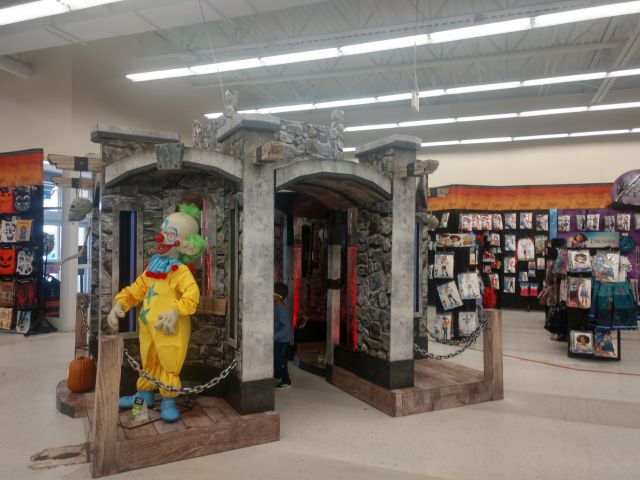

The first things I noticed were the displays. I don’t know what I expected a Spirit Halloween store to look like, but I hadn’t anticipated a full-on haunted house setup complete with creepy clowns and other horror tropes. As I got closer, however, I realized that it was constructed of intersecting cardboard pieces that could easily be taken apart, stored, and transported. The clowns, goblins, and other accessories, moreover, were either costumes or lawn decorations ready to be sold. The carolers at the Vermont Christmas store were intended to be permanent, but here, as far as I could tell, all the displays were both temporary and for sale.
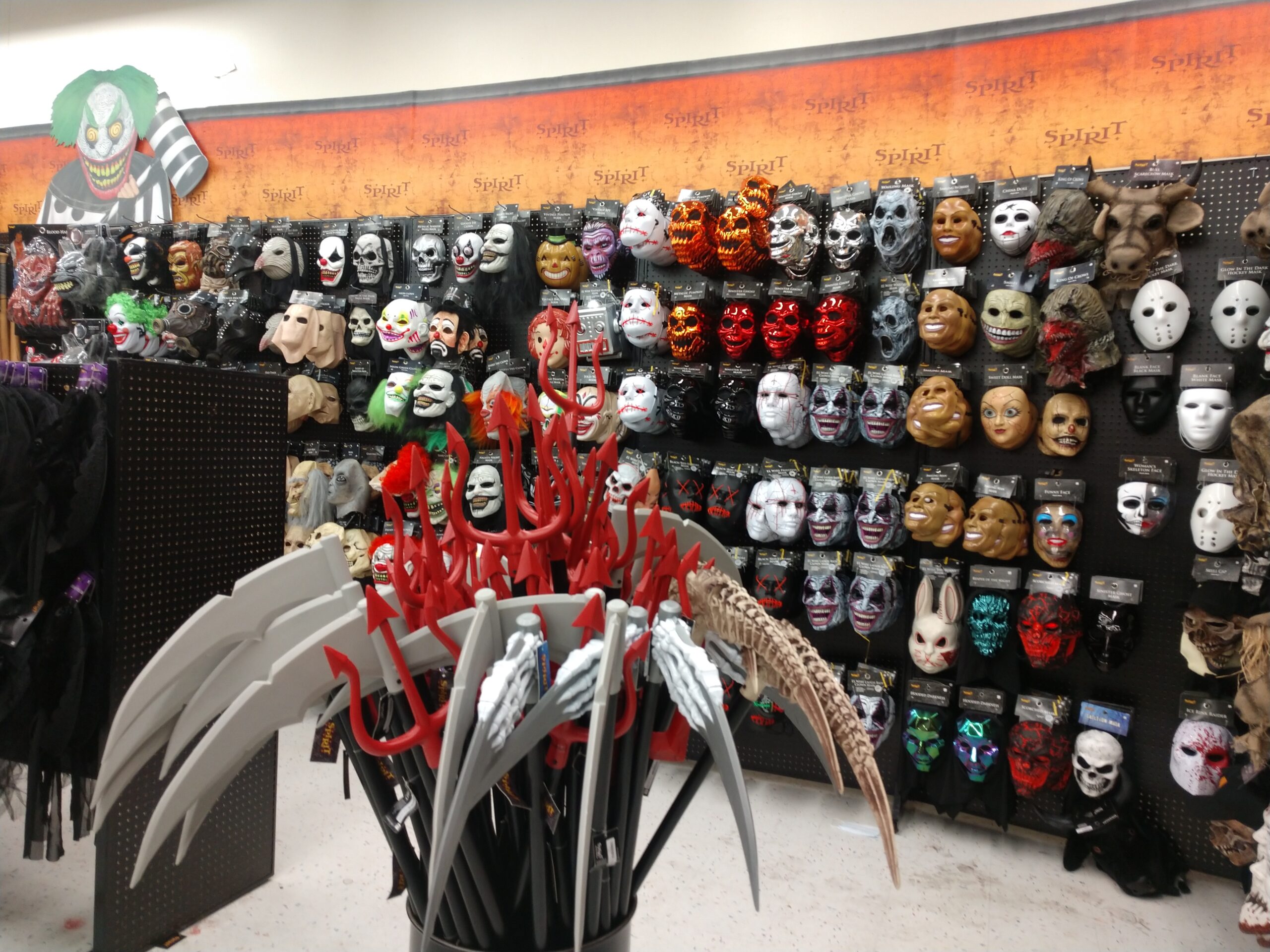
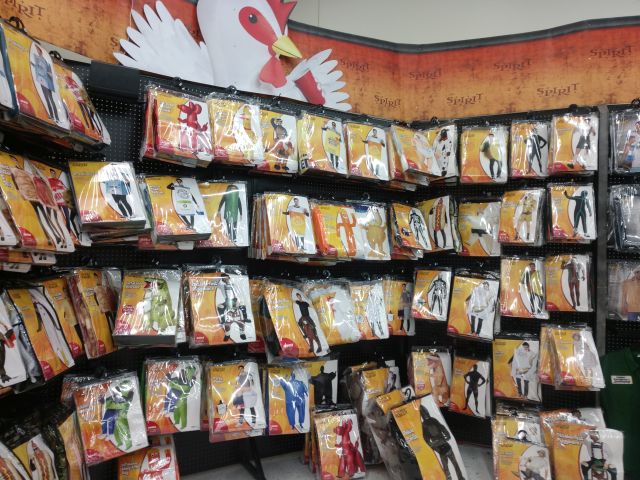
As I got my bearings, I started noticing how the store was organized. Costumes and decorations were sorted into different categories, such as slasher/horror costumes, sexy costumes, funny costumes, couples costumes, and even inflatable ones. A cardboard banner spanned the periphery of the store, with different illustrated characters demarcating the various sections, such as the chicken overlooking the funny costumes. Within these broad categories, subcategories were designated for different accessories, such as a wall for masks, another for weapons, and so on.
What most interested me about the setup, however, was how the store’s impermanence shaped its entire aesthetic. The shop made no effort at concealing the indexical marks of the previous store that had occupied the space. There were still tape marks demarcating the location of desks and other furniture. The floor and walls remained the same bland, off-white as the previous store. The exhibiting furniture used for the merchandise consisted of simple pegboard walls topped with cardboard crenelations, and I could visualize them being taken up or deconstructed with little imaginative effort on my part.
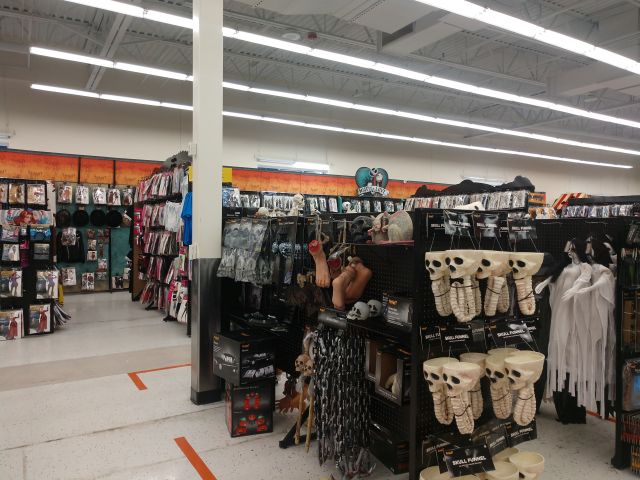
Indeed, I think what struck me was Spirit Halloween didn’t make me think of a holiday store at all. Rather, it felt like an expanded holiday section of a Wal-Mart or similar big box store. It played pop music instead of holiday tunes (I think I heard Selena Gomez’s “Come and Get It” at one point), didn’t have any kind of pumpkin spice scent or other olfactory reminders of the holiday, and didn’t try to suggest the atmosphere of Halloween night by darkening the space or using a fog machine to enhance the eerie atmosphere. Maybe other Spirit Halloween stores do this, but this one didn’t. It was, quite simply, a place to buy your Halloween stuff, nothing more, nothing less.
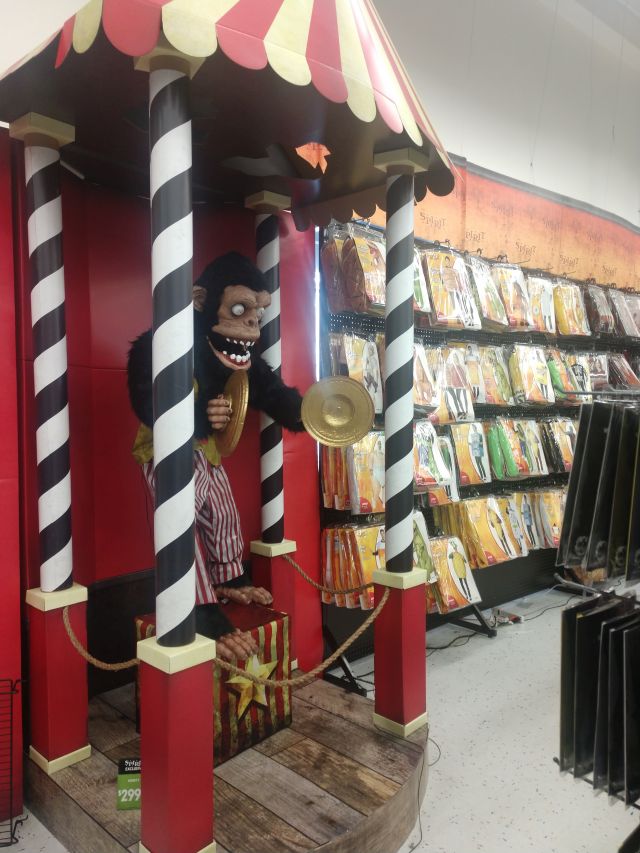
In a way, though, I found Spirit Halloween oddly refreshing. I think one of the reasons why I sometimes find Christmas stores unsettling is that they’re commodifying not just the merchandise of Christmas, but the experience of the holiday. It’s as though the store is telling me that I can recapture the memories of being with my family by buying a few more decorations (and really, given how closely the sense of smell is linked to memory, it comes off as especially sneaky to me). If you’re into that, great, but for me, I find it all a little bit insincere and off-putting. Spirit Halloween by contrast, makes no illusion about what it is: a pop-up store where you can get your costume, decorations, and whatever other supplies you need and be on your way. Both shops are ultimately trying to make money off of you, but their different approaches are compelling. I already have more than enough to research and write with the dissertation, but I could see myself doing an extended study of these shops in the future. I just find them that peculiar.
For all my reservations about Christmas stores though, I can’t be that hard on them. The last time I visited one, I ended up buying three ornaments. In my defense, they were the cheapest ones I could find. I’m not letting them get that much money out of me.